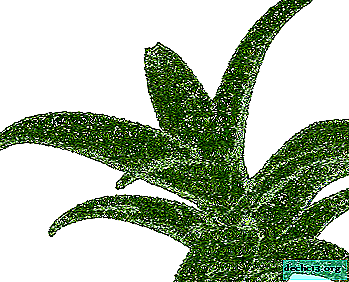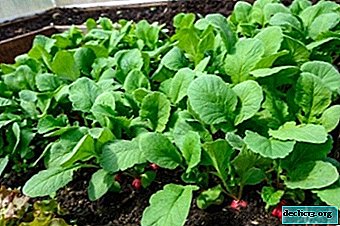Garden Decoration - Rose Harlequin Miam Decor. Description, photos and tips for growing a climbing beauty

Rosa Harlequin Myam Decor is the decoration of any garden. This flower has incredible beauty and aroma.
In order for him to take root and for a long time delight the eye with his blossoming buds, gardeners need to properly care for him.
In the article, we will examine clearly what a Harlequin Myam Decor rose looks like, and also learn how to properly care for a flower.
Description of a variety of climbing plant
This flower - refers to one of the many varieties of park climbing roses. It is often used for decorating and landscaping vertical buildings, and landscape designers call this rose the queen of phytodesign. Due to this, it is called Harlequin Decor.
The main advantages of this plant are its long continuous flowering, good tolerance to frost and resistance to disease. Therefore, it can be grown in regions with a cold climate. After it fades, bright green foliage remains on the bush that adorns any courtyard or building.
If you pay due attention to the flower, it will delight its owners with beautiful flowers and bright foliage, from late spring to mid-autumn. In southern Russia, the Harlequin bush may remain green until early November.In the video, we consider the description of the roses Harlequin Miam Decor:
Appearance
Rosa Harlequin was not in vain a favorite of gardeners. Her bush is growing fast. In height, it can reach three meters, and in width it grows by two meters. Therefore, it can close a wide wall. A healthy plant grows dense and branched, with flexible and durable shoots.
But, of course, his main decoration is flowers. Their feature is a heterogeneous color. A yellow bud that, when opened, acquires a delicate pink or raspberry shade, with a bright yellow or white middle. It is difficult to find flower stalks similar to each other on one branch. Each of them has its own unique color.
The flowers themselves are large, cupped. They can reach up to 10 centimeters in diameter. They lean downward from their own gravity. Their petals are matte and terry. Harlequin Decor blooms profusely. It is rare that only one bud opens on one branch. Most often, flowers appear in clusters of 5-6 pieces.
Photo
We suggest you familiarize yourself with the photo of the flower.





History of occurrence
Harlequin weaving large-flowered rose was launched in 1986, in one of the world's leading horticultural companies, Cordes, named after the family that created it. This company was founded in 1887, and for the second century, gardeners have been pleased with new varieties of flowers, which are famous for their resistance to frost and disease, as well as long and plentiful flowering. Beauty Harlequin was grown by the third generation of the famous family. She has no subspecies, but each flower is unique in its beauty.
Bloom
Flowering Harlequin falls in July, August and September. In regions with a hot climate, it can begin to bloom in early summer. But all gardeners know that this is not easy to achieve. In order for the plant to please with beautiful buds, it is necessary to avoid such common mistakes as:
- Incorrectly selected soil. The soil should be moderately moist and fertile, breathable. You can add peat or sand to it.
- To plant a rose stands in a place not protected from drafts.
- Too often prune the plant.
- Lack of top dressing.
- Rare watering roses in the dry season.
Step-by-step care instructions
 In order for the plant to take root, it should be properly looked after. There are several rules under which it will develop more than one year:
In order for the plant to take root, it should be properly looked after. There are several rules under which it will develop more than one year:
- The best time to plant Harlequin Decor is the middle or end of spring, when the air temperature reaches 20 - 25 degrees Celsius. The first week it is best to cover the seedling with polyethylene or an ordinary cropped plastic bottle. Ventilate it twice a day.
- You need to plant a young plant in light soil. In the earth, with nearby groundwater and containing clay, the roots of the rose quickly rot.
- In the hot season, the rose bush requires regular watering. Its roots quickly dry out, due to its proximity to the surface of the earth.
- Twice a week, it is necessary to loosen the soil. But you need to do this carefully so as not to damage the root system.
- A prerequisite for caring for a climbing rose is its garter to the supports before flowering. This action stimulates the growth of foliage and the appearance of new buds, since when upright, all plant juices are distributed evenly. To fix the stem, you need to use a wire. Garter is carried out in early spring, until the plant begins to actively grow.
- Before the onset of cold weather, the rose needs to be fed, so that it is easier to relieve frost. For these purposes, you can use conventional selective fertilizer.
- Harlequin Decor requires annual pruning, to eliminate dry diseased branches and shoots growing inside the bush, and also so that it does not reach the maximum height. It is better to do this in the spring, when the snow melts and the temperature rises above 10 degrees.
- A rose is transplanted only in October, carefully digging a plant. After planting in a new place, the bush must be fed with fertilizers.
- In late November - early December, the bush must be covered with burlap. It will protect it from strong winds and freezing and will prevent early sap flow during the onset of the first and deceptive heat. The root system also needs to be insulated for the winter with the help of additional soil, on which spruce branches are laid on top.
Important! You can not warm the rose with polyethylene, as it does not allow oxygen to pass through and creates a greenhouse effect. This can harm the plant.
If you follow all the simple rules specified in the instructions, the flower will easily take root and will survive the winter.
Breeding
 Rosa Harlequin propagates only by cuttings. Other ways to get a new plant are not suitable for this variety of flowers. A stalk forms at the time the bud blooms. Until it has bloomed, you can cut off the shoot.
Rosa Harlequin propagates only by cuttings. Other ways to get a new plant are not suitable for this variety of flowers. A stalk forms at the time the bud blooms. Until it has bloomed, you can cut off the shoot.
It is necessary to plant only that process with a green base, avoiding stiff stems. It is simply impossible to get a new bush from them.
- Cut the cuttings at an acute angle 2 centimeters below the end of the stem. The shoots in diameter not exceeding 1 centimeter are well established. They should have no more than four internodes.
- After the cut, the seedling must be cleaned of thorns and leaves, and clean the bottom cut.
- In order for the plant to take root, the upper section must be held in a solution of manganese for 10 minutes, and then dip it in molten wax. This will protect the escape from harmful bacteria.
- Before rooting it must be held for a day in a rooting agent solution.
- Planting the stalk is necessary in a recess in the ground with a diameter of 15 centimeters.
- After the seedling is planted in the soil, it must be poured with a solution of manganese, cover it with soil and cover with a plastic bottle. The greenhouse effect should be observed until the plant has taken root.
Pests
Rosa Harlequin is disease resistant. But there are several pests and bacteria that can kill this plant. These include:
- Spider mite. The leaves of the plant begin to turn yellow and become covered with white threads of a web. In this case, the branches affected by the pest should be cut, and the plant itself should be treated with a solution of horsetail.
- Aphid. These are small insects that feed on plant sap. They cover the buds, stems and foliage of roses. An infusion of wormwood, which needs to spray the entire affected bush, helps to get rid of them.
- Powdery Mildew These are bacteria that form in wet climates due to prolonged rains. The leaves of the rose begin to cover with a white coating. 1% Bordeaux fluid helps get rid of this problem.
- Cicadas. Small parasites that live on the outside of the leaves. You can eliminate them with soapy water. For processing, you need to take only laundry soap.
Rosa Harlequin Decor will be the darling of any gardener. She is very beautiful and unpretentious. If you monitor her condition, get rid of the parasites attacking her in time, and properly prepare her for the winter, then she will delight every year with amazing multi-color buds and bright foliage.

















